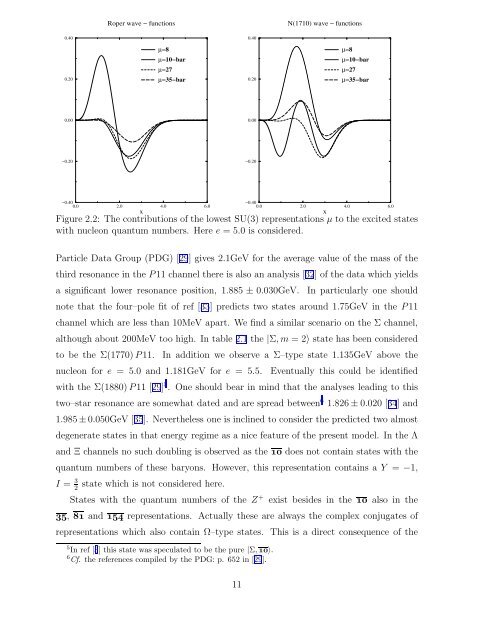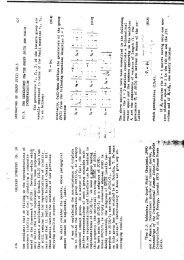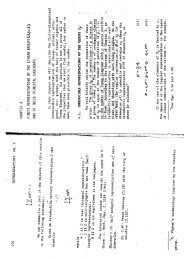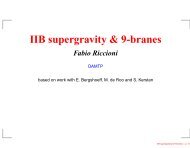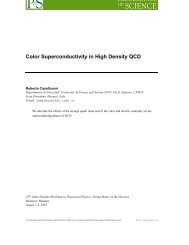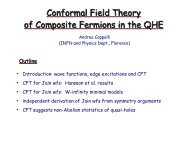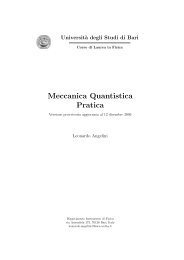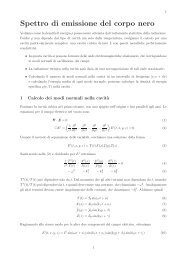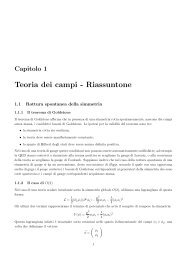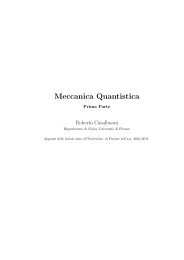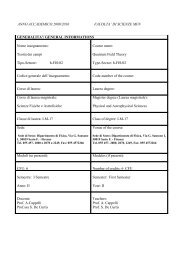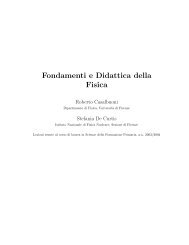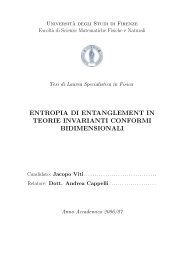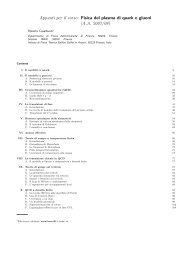arXiv:hep-ph/9804260 v2 16 Jun 1998 - Florence Theory Group
arXiv:hep-ph/9804260 v2 16 Jun 1998 - Florence Theory Group
arXiv:hep-ph/9804260 v2 16 Jun 1998 - Florence Theory Group
You also want an ePaper? Increase the reach of your titles
YUMPU automatically turns print PDFs into web optimized ePapers that Google loves.
0.40<br />
0.20<br />
0.00<br />
−0.20<br />
Roper wave − functions<br />
−0.40<br />
0.0 2.0 4.0 6.0<br />
x<br />
µ=8<br />
µ=10−bar<br />
µ=27<br />
µ=35−bar<br />
0.40<br />
0.20<br />
0.00<br />
−0.20<br />
N(1710) wave − functions<br />
−0.40<br />
0.0 2.0 4.0 6.0<br />
x<br />
µ=8<br />
µ=10−bar<br />
µ=27<br />
µ=35−bar<br />
Figure 2.2: The contributions of the lowest SU(3) representations µ to the excited states<br />
with nucleon quantum numbers. Here e = 5.0 is considered.<br />
Particle Data <strong>Group</strong> (PDG) [29] gives 2.1GeV for the average value of the mass of the<br />
third resonance in the P11 channel there is also an analysis [32] of the data which yields<br />
a significant lower resonance position, 1.885 ± 0.030GeV. In particularly one should<br />
note that the four–pole fit of ref [33] predicts two states around 1.75GeV in the P11<br />
channel which are less than 10MeV apart. We find a similar scenario on the Σ channel,<br />
although about 200MeV too high. In table 2.1 the |Σ, m = 2〉 state has been considered<br />
to be the Σ(1770) P11. In addition we observe a Σ–type state 1.135GeV above the<br />
nucleon for e = 5.0 and 1.181GeV for e = 5.5. Eventually this could be identified<br />
with the Σ(1880) P11 [29] 5 . One should bear in mind that the analyses leading to this<br />
two–star resonance are somewhat dated and are spread between 6 1.826 ± 0.020 [34] and<br />
1.985 ±0.050GeV [35]. Nevertheless one is inclined to consider the predicted two almost<br />
degenerate states in that energy regime as a nice feature of the present model. In the Λ<br />
and Ξ channels no such doubling is observed as the 10 does not contain states with the<br />
quantum numbers of these baryons. However, this representation contains a Y = −1,<br />
I = 3 state which is not considered here.<br />
2<br />
States with the quantum numbers of the Z + exist besides in the 10 also in the<br />
35, 81 and 154 representations. Actually these are always the complex conjugates of<br />
representations which also contain Ω–type states. This is a direct consequence of the<br />
5 In ref [3] this state was speculated to be the pure |Σ, 10〉.<br />
6 Cf. the references compiled by the PDG: p. 652 in [29].<br />
11


